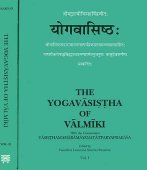Final release: 1 definition
Introduction:
Final release means something in Hinduism, Sanskrit. If you want to know the exact meaning, history, etymology or English translation of this term then check out the descriptions on this page. Add your comment or reference to a book if you want to contribute to this summary article.
In Hinduism
Shaktism (Shakta philosophy)
Source: Google books: Genesis and Development of Tantra (Shaktism)Final Release is denoted by the Sanskrit term Mokṣa and represents one of the various Supernatural Powers (siddhi) according to the Siddhayogeśvarīmata: an ancient Sanskrit text devoted to cults of Goddesses as the Vidyāpīṭha or Vidyā Corpus.—In the Siddhayogeśvarīmata, the objectives of rituals are classified as siddhis [e.g., final release (mokṣa)]. They belong to the category of supernatural phenomena and seem to be considerably different from the types of wish people expected to gain from the Vedic rituals that still remained within the sphere of everyday life.

Shakta (शाक्त, śākta) or Shaktism (śāktism) represents a tradition of Hinduism where the Goddess (Devi) is revered and worshipped. Shakta literature includes a range of scriptures, including various Agamas and Tantras, although its roots may be traced back to the Vedas.
See also (Relevant definitions)
Partial matches: Release.
Query error!
Full-text (+4): Parinirvana, Mokkha, Kubja, Parinibbayi, Moksha, Nivritti, Nirveda, Amrita, Hanuman, Anamaya, Samkhya, Jnanakanda, Puryashtaka, Kriyakanda, Alcohol, Prasankhyana, Nirvana, Preshyatyagapratima, Brahmapraptyupaya, Vairaja.
Relevant text
Search found 49 books and stories containing Final release; (plurals include: Final releases). You can also click to the full overview containing English textual excerpts. Below are direct links for the most relevant articles:
Brahma Sutras (Shankaracharya) (by George Thibaut)
IV, 1, 16 < [Fourth Adhyāya, First Pāda]
II, 3, 39 < [Second Adhyāya, Third Pāda]
II, 2, 6 < [Second Adhyāya, Second Pāda]
Brahma Sutras (Ramanuja) (by George Thibaut)
The conscious subject persists in the state of release < [First Adhyaya, First Pada]
Sutra 3.4.51 < [Third Adhyaya, Fourth Pada]
Sutra 1.1.7 < [First Adhyaya, First Pada]
Manusmriti with the Commentary of Medhatithi (by Ganganatha Jha)
Verse 2.93 < [Section XVIII - Control of Sensual Desires]
Verse 2.28 < [Section VIII - Duties and Sacraments]
Verse 1.113-116 < [Section LXII - Contents of the Treatise]
Brahma Sutras (Shankara Bhashya) (by Swami Vireshwarananda)
Chapter III, Section IV, Adhikarana XVII < [Section IV]
Chapter II, Section II, Adhikarana IV < [Section II]
Ishavasya Upanishad with Shankara’s Commentary (by M. Hiriyanna)
Yuktimallika by Vadiraja (critical study) (by Gururaj K. Nippani)
5. Liberation is the attainment of the abode of lord Visnu < [Critical exposition (5) Phalasaurabha]
12. Critical exposition of the Purusasukta < [Critical exposition (2) Suddhisaurabha]
10. Interpretation of the Sruti, ‘rupam rupam pratirupo bhabhuva’ < [Critical exposition (5) Phalasaurabha]
Related products
